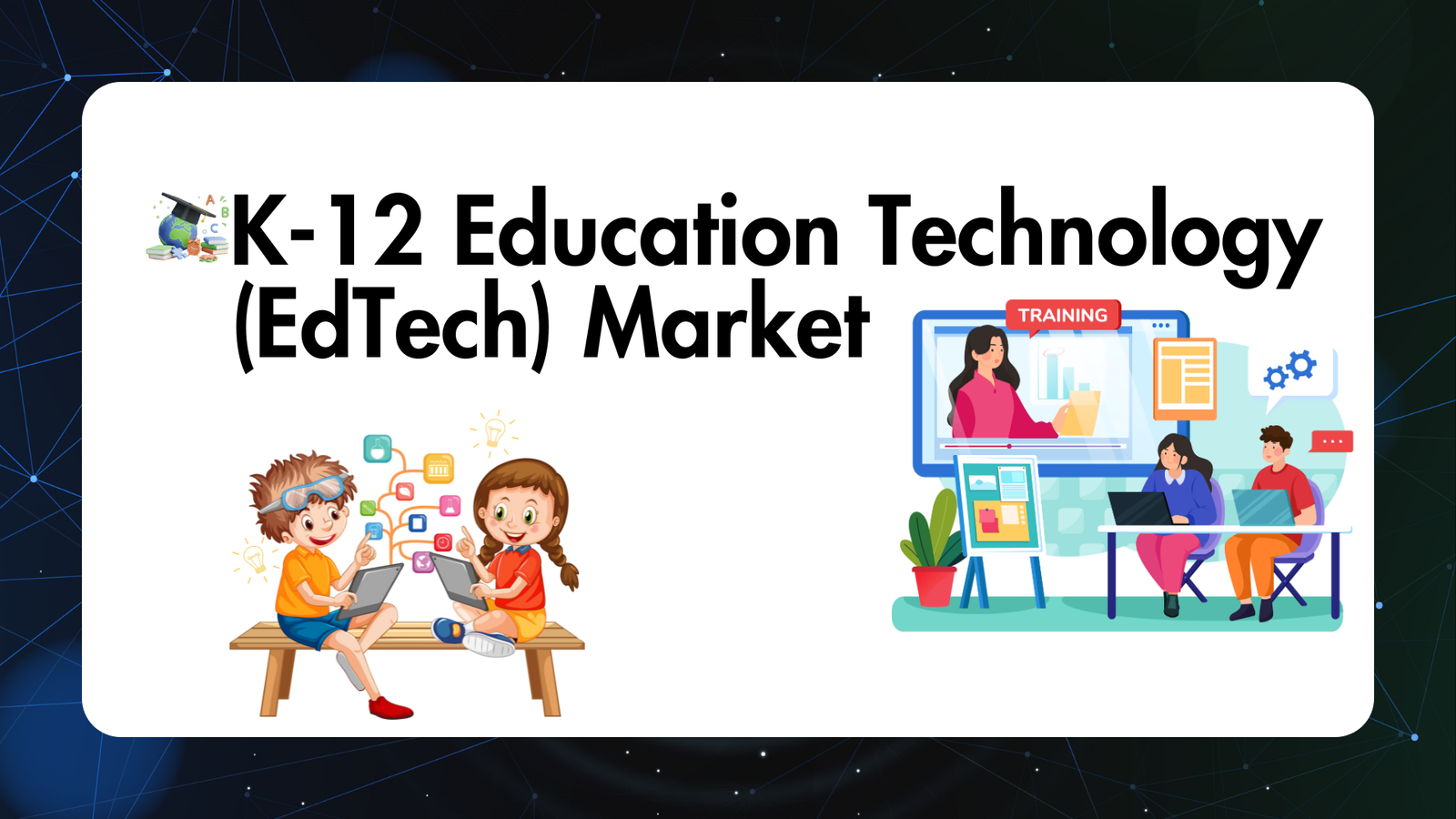K-12 Education Technology (EdTech) Market to reach USD 253.9 Bn By 2033
Updated · Aug 26, 2025

WHAT WE HAVE ON THIS PAGE
Introduction
The Global K-12 Education Technology (EdTech) Market is experiencing strong growth as digital learning tools and platforms reshape the education landscape. Valued at USD 78.2 Billion in 2023, the market is expected to reach nearly USD 253.9 Billion by 2033, expanding at a CAGR of 12.5% from 2024 to 2033. The rise of interactive learning platforms, increased adoption of cloud-based solutions, and growing emphasis on personalized education are driving this expansion, making technology a central pillar in modern K-12 learning environments.
The K‑12 Education Technology market refers to the set of digital tools and platforms used in schools from kindergarten to grade twelve. This includes software such as learning management systems, student information systems, online tutoring, educational apps, and digital content, as well as hardware such as tablets and interactive boards. These tools are used to support teaching and learning, and to enhance how students and educators interact with educational material.
The top driving factors behind the adoption of EdTech in K‑12 include the rising need for learning experiences tailored to individual students and the growing shift toward online and blended learning models. Schools seek solutions that adapt to unique learning styles and provide real‑time feedback. Moreover, cloud‑based platforms are preferred because they are flexible, scalable, and support both in‑person and remote instruction.

According to Market.us research analysis, the global EdTech market is entering a phase of sustained expansion as digital adoption accelerates in both academic and corporate learning environments. The market, valued at USD 146.0 Billion in 2023, is projected to reach approximately USD 549.6 Billion by 2033, reflecting a CAGR of 14.2% over the forecast period. This growth is supported by rising demand for online learning solutions, personalized education platforms, and the integration of advanced technologies in classrooms worldwide.
Within this broader market, the role of artificial intelligence is becoming increasingly central. The Global Generative AI in EdTech segment is forecasted to expand from USD 268 Million in 2023 to nearly USD 8,324 Million by 2033, advancing at a remarkable CAGR of 41%. Similarly, the AI in EdTech market is set to grow from USD 3.65 Billion in 2023 to about USD 92.09 Billion by 2033, with a CAGR of 38.1%. These figures highlight how AI-driven innovations, ranging from adaptive learning tools to automated content generation, are reshaping educational delivery.
The global EdTech and Smart Classroom market is also contributing to this momentum. Valued at USD 146.8 Billion in 2023, it is expected to achieve nearly USD 498.5 Billion by 2032, recording a steady CAGR of 15%. Enhanced classroom interactivity, cloud-based learning management systems, and immersive technologies are key drivers in this segment, supporting hybrid and flexible learning models.
The transformative impact of technology on education is reflected in adoption patterns and educator readiness. A survey by EdWeek found that 87% of K-12 educators improved their technology skills during the pandemic, underscoring the long-term shift toward digital teaching methods. Research also indicates that students who engaged with digital devices for more than 60 minutes per week recorded stronger academic outcomes, though the effect varies across regions.
Beyond schools, corporate learning represents another dynamic area within the industry. The corporate EdTech market has reached USD 27.5 Billion, with enterprises increasingly investing in digital platforms to upskill employees and enhance workforce productivity. Notably, more than 70% of schools and universities are planning to introduce one or more online undergraduate programs within the next three years, highlighting the continued convergence of technology and education across sectors.
Key Takeaways
- The K-12 EdTech Market is projected to expand from USD 78.2 billion in 2023 to nearly USD 253.9 billion by 2033, registering a steady CAGR of 12.5% over the forecast period.
- In 2023, the Cloud segment dominated deployment models, capturing over 70% share, supported by the demand for scalable, flexible, and accessible digital learning platforms.
- The Software segment maintained strong momentum, holding 41% share, as schools and institutions increasingly adopted interactive platforms, learning management systems, and AI-enabled tools.
- The K-12 education level remained the market’s core driver, accounting for more than 70% share, reflecting widespread integration of digital solutions across primary and secondary schools.
- The Consumer segment led with over 80% share, as students, parents, and individual learners drove significant adoption of online education resources and digital content.
- Regionally, North America held the dominant position with 36% share, generating revenues of USD 28.1 billion in 2023, supported by advanced infrastructure, strong digital literacy, and government-backed initiatives.
Driver Factor
Government Involvement and Funding
Government involvement is a major driver in the growth of the K-12 EdTech market. Investments supporting digital equity programs and funding for educational infrastructure have significantly boosted adoption rates. For instance, in places like the U.S. and U.K., increased government spending helps provide schools with access to online learning tools and technology, thus encouraging widespread use of EdTech solutions. This investment not only closes gaps in access but fosters innovation and the integration of advanced technologies that cater to personalized learning needs.
Additionally, government initiatives ensure that students from disadvantaged backgrounds receive additional support through targeted funding. This drives inclusivity and equal opportunity in education, making EdTech a vital tool for national education improvement goals. As policies continue to prioritize digital literacy and interactive learning models, such involvement underpins the sustained growth and modernization of K-12 education systems globally.
Restraint Factor
Infrastructure Gaps in Underserved Areas
One significant restraint impacting the K-12 EdTech market is the persistent digital infrastructure gap in many regions, especially rural and developing areas. Despite advances in technology, a sizable portion of schools still lack reliable internet connectivity or modern hardware, limiting effective EdTech adoption. This digital divide directly hampers efforts to implement seamless and interactive learning platforms, leaving large student populations underserved and slowing nationwide digital education progress.
Moreover, inadequate infrastructure also affects the quality of tech-based instruction, as educators may struggle without proper resources or technical support. The cost and complexity of overcoming these gaps can pose substantial challenges for school districts, particularly those with limited budgets. This restraint underscores the ongoing need for infrastructure development to unlock EdTech’s full potential.
Opportunity Analysis
Integration of Artificial Intelligence and Personalized Learning
The integration of artificial intelligence (AI) within K-12 EdTech holds transformative potential and represents a key market opportunity. AI-powered tools enable personalized learning experiences by tailoring educational content and assessments to individual student needs and learning styles. This adaptability enhances student engagement and efficacy, helping educators identify learning gaps and optimize instructional strategies with data-driven insights.
Furthermore, AI can automate administrative tasks such as grading and lesson planning, freeing teachers to focus more on direct student interaction and fostering creativity. As adoption of AI-driven platforms grows, the opportunity to develop innovative educational models that support inclusivity, accessibility, and efficiency will reshape traditional learning paradigms and expand market possibilities.
Challenge Analysis
Educator and IT Staffing Shortages
A pressing challenge in the K-12 EdTech market is the shortage of qualified educators and IT professionals to support technology integration and maintenance. Many school districts face difficulties in attracting and retaining professionals due to factors such as low job satisfaction, noncompetitive salaries, and high workload demands. This results in understaffed IT departments and fewer educators proficient with EdTech tools, which impedes effective implementation and usage.
The gap in skilled personnel also affects training and professional development, leaving teachers less prepared to fully leverage new technologies in classrooms. Without sufficient support, the risk of technology underutilization rises, slowing digital transformation efforts and reducing the overall impact of EdTech investments.
Key Market Segments
By Deployment Mode
- Cloud
- On-Premise
By Type
- Hardware
- Software
- Content
By Sector
- Preschool
- K-12
By End-User
- Business
- Consumer
Top Key Players in the Market
- Duolingo
- Mcgraw-hill Education
- ABCmouse
- IXL Learning
- Seesaw
- DreamBox Learning
- Epic!
- Blockly
- Byju’s
- Panorama Education
- Outschool
- Other Key Players
Sources

Aruna is an editor at Techno Trenz and knows a lot about SEO. She is good at writing and editing articles that readers find helpful and interesting. Aruna also makes charts and graphs for the articles to make them easier to understand. Her work helps Techno Trenz reach many people and share valuable information.




